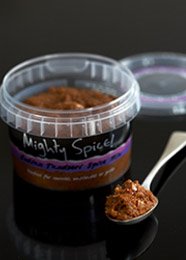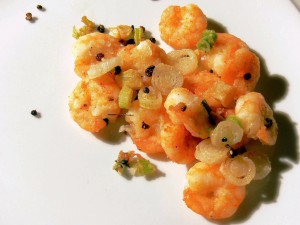 Update, 28 Oct 2008 – I’m very pleased to be able to tell you that Sainsbury’s has seen the light, and is now stocking Mighty Spice at selected butchers’ counters, so you’re not going to have to drive to London to buy your own tub any more.
Update, 28 Oct 2008 – I’m very pleased to be able to tell you that Sainsbury’s has seen the light, and is now stocking Mighty Spice at selected butchers’ counters, so you’re not going to have to drive to London to buy your own tub any more.
A couple of weeks ago, the nice people at The Mighty Spice Company sent me three of their chilled spice mixes to sample. Exciting stuff, this; I’ve not found anything similar to these fresh blends on sale in the UK. The Mighty Spice Company’s offering is a really refreshing change from the oily, musty pastes and sauces you’ll find on offer in the supermarket which taste vaguely of foreign – instead, these blends are made from fresh ingredients without fillers and additives (so they need to be kept refrigerated), and are really well-judged, with clean and subtle balances of flavour. They’ve been in development for two years, and you can really taste the effort that’s gone into tweaking these mixtures to perfection.
Currently, the range includes a Szechwan mix, a Tandoori mix and a Thai Green mix. All three come with simple recipes on the side of the pack (recipes are also available on the Mighty Spice website), but the mixes are so flexible that you can (as, inevitably, I did – I’m very bad at following instructions) improvise around them very successfully. I was really chuffed to find that the mixes are comprehensive enough that I was able to make a positively fantastic stir-fry without having to add (and chop – hooray!) any ginger, garlic or other spices – and the balance of soy sauce and oyster sauce forming the background of the mix was spot on, so I didn’t have to add any wet ingredients either. I made a lamb curry with the tandoori mix, some crushed tomatoes and coconut – especially good the next day, after a night in the fridge to let the flavours mingle, and again, it needed absolutely no additions to the very well-blended spice mix. The Thai mix was a bit milder than I would usually have chosen, but tasted green and fresh.
My favourite? Probably the Szechwan spice mix, which was loaded with Szechwan peppercorns. It’s a good way into the spice for those of you who aren’t familiar with it and its curious tongue-numbing (but not painful) heat, a sensation a little like a cross between a mint leaf and a chilli. In taste it’s nothing like mint or chilli, but pleasantly citric. None of your syrupy, Chinese-sauce-inna-jar flavours here; this was a really bright, lively sauce that worked well with some chicken and sweet vegetables.
I’m sure it won’t be long before you’re able to find The Mighty Spice Company’s products on sale in a supermarket chiller cabinet near you, but for now they’re very new and are mostly available in London. You’ll find the spice mixes stocked at Wholefoods Market, Selfridges, Harvey Nichols and several organic grocers – a complete list of stockists is available here. I’d heartily recommend you spend the £3.99 on one of their mixes for a professional, easy and hopelessly tasty supper. Brilliant stuff – thanks, Mighty Spice guys!

